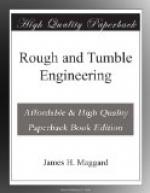Your engine may however act very queer some time, and you may find the eccentrics in their proper place. Then you must go into the steam chest for the trouble. The valves in different engines are fastened on valve rod in different ways. Some are held in place by jam nuts; a nut may have worked loose, causing lost motion on the valve. This will make your engine work badly. Other engines hold their valve by a clamp and pin. This pin may work out, and when it does, your engine will stop, very quickly to.
If you thoroughly understand the working of the steam, you can readily detect any defect in your cylinder or steam chest, by the use of your cylinder cocks. Suppose we try them once. Turn your engine on the forward center, now open the cocks and give the engine the steam pressure. If the steam blows out at the forward cock we know that we have sufficient lead. Now turn back to the back center, and give it steam again; if it blows out the same at this cock, we can conclude that our valve is in its proper position. Now reverse the engine and do the same thing; if the cocks act the same, we know we are right. Suppose the steam blows out of one cock all right, and when we bring the engine to the other center no steam escapes from this cock, then we know that something is wrong with the valve, and if the eccentrics are in their proper position the trouble must be in the steam chest, and if we open it up we will find the valve has become loosened on the rod. Again suppose we put the engine on a center, and on giving it steam, we find the steam blowing out at both cocks.
Now what is the trouble, for no engine in perfect shape will allow the steam to blow out of both cocks at the same time. It is one of two things, and it is difficult to tell. Either the cylinder rings leak and allow the steam to blow through, or else the valve is cut on the seat, and allows the steam to blow over. Either of these two causes is bad, as it not only weakens your engine, but is a great waste of fuel and water. The way to determine which of the two causes this, is to take off the cylinder head, turn engine on forward center and open throttle slightly. If the steam is seen to blow out of the port at open end of cylinder, then the trouble is in the valve, but if not, you will see it blowing through from forward end of cylinder, and the trouble is in the cylinder rings.




